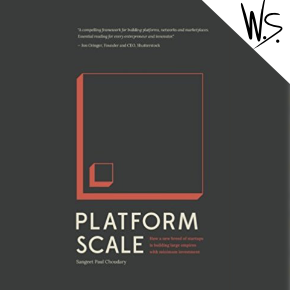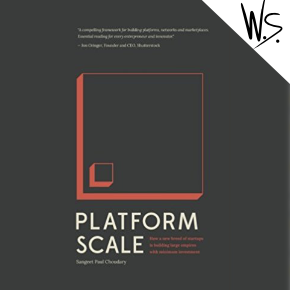平台规模:总结与回顾

关键词: 设计、基础设施、交互、货币化、网络效应、平台、启动、规模、交易、病毒式传播
请注意: 本文末尾有指向其他评论、摘要和资源的链接。
书评
信息革命带来了一种新的商业模式:平台。平台业务就像一个基础,上面还有其他东西,比如应用程序和产品。平台本身不会产生太多价值,而上面的东西才会产生价值。平台的例子包括 YouTube(一个提供视频的平台)和 Amazon(一个提供商品的平台)。
银行、教育、医疗保健——很难想象哪个行业没有受到平台业务的颠覆。随着平台的出现,它们改变了所接触的一切。当今的专业领导者必须了解这种新模式,否则就有被淘汰的风险。
平台秤 本书探讨了平台理论的复杂性,并解释了如何使用这些知识来创建和管理平台业务。本书提供了平台设计的说明,从核心价值单元开始,然后从那里开始构建。本书列举了来自著名新经济公司(如亚马逊、Reddit 和许多其他企业)的案例。本书还有一个配套网站: www.platformed.info。 (仔细输入,platform.info 会带你到别处。)
这本书非常易读。作者 Sangeet Paul Choudary 在理论和实践指导之间游刃有余。这本书以实用为导向,为设计师提供了大量好建议。虽然这本书是为平台设计师编写的,但它避免了过多术语的陷阱。在大多数情况下,普通外行人可以毫无困难地理解这些材料。但有一个明显的例外,也许太明显了,以至于 Choudary 没有注意到。虽然平台的概念定义得很好,但平台的概念 规模 并非如此。具有经济或商业背景的人很容易理解规模与大小有关,扩大公司规模意味着发展公司。然而,外行人并不总是知道专业人士认为显而易见的事情。本书的组织结构有一个缺陷:缺少索引。使用本书作为参考的平台设计人员肯定会希望在遇到具体问题时查找它们,但他们无法这样做。
在出版这部作品的一年内,乔达里继续出版 平台革命.奇怪的是, 革命 几乎相同 平台秤. 规模具有比 革命.大多数平台公司的现实生活例子出现在 规模 也出现在 革命,尽管后者包括了未出现在 规模.除了 Choudary 之外,Revolution 还提到了另外两位作者:Geoffrey Parker 和 Marshall Van Alstyne。
这些书几乎完全相同,以至于除了最忠实的读者之外,所有人都可能不想花时间阅读它们。在决定阅读这两本书中的哪一本时,最重要的考虑因素可能是学习风格。那些可以通过阅读其他人如何构建平台业务的例子来学到很多东西的人会想要阅读 革命;对这种叙述感到厌烦的人会在 规模.
概括
第 1 章:交互优先业务简介
过去最流行的商业模式是管道,即企业生产商品、消费者消费商品的管道。价值在上游创造,并流向下游。如今,平台模式在商业世界中越来越流行。平台本身创造的价值很少,而是为生产者和消费者提供空间,以前所未有的方式进行联系和互动。平台的用户创造价值。
平台代表了企业设计的根本性变化。连接性的增加、分散的生产和人工智能正在推动这种新设计的兴起。
平台导致市场发生三个主要转变:
- 平台上的参与者包括客户和生产者。例如,亚马逊用户包括买家和卖家;优步用户包括司机和乘客。
- 竞争优势也从资源转向生态系统。以前,大玩家是支配资源的人;他们有很多员工和很多实物资产。平台创造了消费者和生产者的生态系统,成功的平台擅长创建和培育这个生态系统。
- 第三个转变是价值创造,从流程到互动。正是互动的协调在平台上创造了价值。
平台规模取决于公司利用和协调生产者和消费者的全球生态系统的能力,从而有效促进交流并创造价值。
管道业务模式的旧规则不再适用。生态系统是新的仓库和新的供应链。网络推动规模——使用平台的人越多,平台的价值就越大。
该平台需要改变思维方式:
- 数据是新的美元。
- 供给和需求都必须存在于满足生产者和消费者的水平。
- 策展和声誉是新的质量控制。
- 用户旅程是新的销售渠道。
- 分销是新的目的地。
- 行为设计是新的忠诚度计划。
第 2 章:设计交互优先平台
单靠技术无法创造价值。一些高价值平台的技术比较简单。价值来自于生态系统,或许更重要的是平台上的互动。
平台本身不会产生太多价值。它是一个底层基础,其他东西(如应用程序)都建立在此基础之上。不要将平台视为基础设施,而要将其视为网络。信息在用户(生产者和消费者)之间传递。平台需要数据来提供建议并促进交易。
价值单位是在生产者和消费者之间的这些互动中创造的。一个平台要想成功,就需要不断地创建这些单元。需要了解应该存在什么样的供应,以便进行交互。
在 秩序的本质克里斯托弗·亚历山大 (Christopher Alexander) 谈到了建筑和从中心向外构建。平台也是如此。确定中心并向外构建可以减少笨重且不适合的功能出现的可能性。核心价值单元是在平台上创建的最小独立价值单元。如果没有销售清单,eBay 就什么都不是;如果没有图片,Instagram 就毫无意义。这些功能构成了核心价值单元。
核心价值必须在平台堆栈的上下文中考虑,决定平台如何运作的组件。主要有以下三种模式:
- 网络主导——如果存在市场,则列出待售商品的广告是核心价值单位。如果市场是标准服务,则服务列表是价值单位。如果市场是非标准服务(换句话说,无法现成购买的东西),则提供商的列表构成价值单位。
- 基础设施主导——应用程序构成开发平台上的核心价值单元。内容平台上的最小价值单元是内容——例如 YouTube 上的视频。有时这些单元可以由多个制作人创建,就像维基百科一样。在这种情况下,必须考虑创作者的经验。
- 数据主导——无论是 Nest 恒温器还是零售忠诚度计划,数据主导平台的价值单位是数据——即它们传输的信息。
创建交互需要价值单元。平台设计应该是创造价值:价值单元越多或单元的价值越高,平台价值就越大。但是,值因用户类型而异。对于生产者来说,平台是创造或储存价值的地方,是寻找客户的市场。对于消费者而言,平台会为他们筛选出最相关的价值单元。
要建立平台业务,首先要确定核心价值单元,然后围绕核心价值单元构建核心交互。然后设计流程 — 例如,流程可能包括制作者发布广告、消费者查看广告、进行购买以及 PayPal 处理付款。在此示例中,广告是核心价值单元。虽然平台可能有多种价值单元或交互,但有一种是业务的核心。
围绕这个核心交互设计平台,并通过这个镜头评估所有添加的特性和功能。如果在一个平台上有不同种类的交互,它们必须一次设计一个,从中心开始。
互动需要三个要素:生产者、消费者和平台。互动总是涉及信息、商品和/或服务以及货币的交换,而筛选器是交易的核心。丰富性导致选择过多,如果很难找到想要的东西,人们可能会放弃平台。
一个好的平台具有足够的弹性,因此用户可以将其带到意想不到的方向。有随机性。有运气。平台需要允许紧急行为。它有时可以将平台带入一个新的方向。
第 3 章:构建交互优先平台
在平台上有多种不同的方式来驱动交互:预先存在的关系、内容创建和消费、协调、竞争、文化等。一些用户通过影响力驱动交互。平台通常有多个驱动程序,不同的驱动程序可能会产生非常不同的结果。
要设计一个平台,了解生产者的动机至关重要。进入市场非常重要,因此简化生产的工具非常有用。还应该有良好的策划,将最好的内容推向顶峰,并制定明确的规则,以便每个人都能获得顶级内容。非货币激励措施也很重要——比如声誉和认可。建立将消费者转化为生产者的机制,并让消费者向生产者提供反馈,这是很好的。
累积价值使您使用的平台越多,它就越有价值。有四种:
- 名声。
- 影响。
- 收藏。制作人可以拥有他们的作品集。
- 学习过滤器。使平台更适合个人。
摩擦会影响互动。如果摩擦妨碍了互动的顺利进行,那就不好了。如果摩擦能减少不良行为,那就好办了。摩擦可以成为质量的来源。摩擦可以成为信号的来源(例如,LinkedIn 的个人资料设置过程很长,但随后会提供非常详细的信息)。摩擦也可以成为障碍;例如,有时人们不想或不能支付会员费。一如既往,一切都与互动有关。评估摩擦如何影响互动。
策划为新消费者提供了决策依据,让最好的产品脱颖而出。社交策划可以通过点赞、评论等方式实现。让人们尝试某样东西然后表达自己的意见是件好事,这让他们有机会进入这个领域。一旦表达了意见,社交策划就开始了。
平台应该有某种形式的质量排名,并允许制作者提供反馈。对某种形式的内容或服务进行抽样的成本越高,达到社交策划效果所需的时间就越长。这就是为什么在抽样成本较高的平台上,社交策划往往效率较低。
互动需要信任:了解某人的身份可以增加信任。主持人的参与可以建立信任。社区反馈、规范行为、文化、信息完整性和保险也是如此。
交互失败意味着,无论出于何种原因,交互都没有导致交易。交互失败的一个典型例子是 Uber 和 Lyft 之间的竞争。Uber 玩弄阴谋诡计。他们雇佣人员使用一次性手机,打电话给 Lyft 订车,然后取消订单。所有这些取消订单的行为都搞乱了系统,用户离开了平台。交互失败应该避免,但一旦发生,就需要进行跟踪。
保持平台上的互动很重要。有些服务需要当面讨论。风险在于用户会绕过平台并进行交易,而平台不会从中分一杯羹。有办法提供激励措施来保持平台上的交易。平台可以收取广告费,或要求订阅。添加功能(例如发票服务)可以让用户觉得留在平台上是值得的。工作流管理工具尤其受欢迎,但实际上任何管理任务都可能增加价值。
第 4 章:解决先有鸡还是先有蛋的问题
平台存在一个先有鸡还是先有蛋的问题:如何让平台的两边都有足够的用户,以达到平台运营所需的临界规模。解决这个问题的一种方法是找到能够吸引市场一方的东西,即使另一方尚未开发。然而,一旦一方参与进来,重要的是确保反馈循环中没有摩擦——没有用户参与的障碍。平台需要尽快达到临界规模。要意识到这一点,并为他们量身定制激励措施。
在某些情况下,可以以独立模式启动,无需用户。但必须有一种方式,即使其他人还没有加入,用户也可以享受它,即一个钩子。用户之所以会注册,是因为他们喜欢钩子的功能,而不是因为他们承诺将来会与其他用户组成一个社区。OpenTable 通过为餐厅提供可作为独立应用程序运行的预订管理系统来实现这一点。在足够多的餐厅加入平台后,OpenTable 添加了一项允许公众预订的功能。Delicious 最初推出了一款工具,允许人们将浏览器书签存储在云端。在大量用户加入后,添加了社交功能,以便人们可以共享书签。有了一个互动用户社区,网络效应开始显现。
另一种方法是伪造。伪造的个人资料可以给人一种假象,让人以为社区已经存在了很长时间,足以吸引用户加入,从而形成一个真正的社区。当系统上没有足够的交易时,可以通过从卖家那里进行真正的购买等方式来播种需求。然而,伪造和播种等策略必须谨慎对待,因为它们可能会适得其反。
现实情况是,有些用户比其他用户更难吸引。您可以通过提供奖励让较难吸引的用户加入 — 较容易吸引的用户会加入。夜总会在“女士之夜”向女性提供廉价或免费饮品时使用这种策略。女性被廉价饮品的承诺吸引到酒吧,而男性被吸引是因为有女性在场。
平台都是独一无二的,从来没有一种万能的解决方案来获取用户。然而,本章中介绍的案例为开发解决方案提供了一个很好的起点。
第 5 章:病毒式传播:网络世界中的规模
平台是由增长推动的,而增长是通过增加用户和互动来创造的。
病毒增长的趋势被称为 病毒式传播,保证触发拼写检查的单词。病毒式传播不同于口耳相传,当人们听说新事物并想要尝试时。通过病毒式传播,人们通过使用它来发现新事物。例如,有人向他们的朋友发送 YouTube 视频的链接。收件人单击链接并通过观看视频、作为平台用户参与来发现 YouTube。
病毒式传播不同于网络效应。网络效应来自平台内部的增长。例如,LinkedIn 上的人越多,你通过其消息系统联系的人就越多。但是,你不能使用该系统向未使用 LinkedIn 的人发送电子邮件。病毒式传播意味着一个平台正在从其他平台吸引用户。Gmail 具有病毒式传播,因为你可以使用该平台向其他平台(如 Hotmail)发送电子邮件。希望该平台通过与其他平台的联系获得的曝光度能够吸引新用户。但是请记住,病毒式传播是好的,但它不能是你唯一的增长策略。
病毒式传播应该很好地融入平台,而不会让人感到尴尬。不应鼓励人们为了病毒式传播而无谓地向朋友发送垃圾邮件。将其视为设计问题。找到激励其传播的方法。
制作可以传播到其他网络的核心价值单元。例如,用户可以轻松地在任何地方分享 JPEG,但全息图就不那么容易了。不要将全息图作为平台的核心价值单元。人们将无法轻易传播它们。传播开来的单元就像平台的广告。
在选择用于传播单位的网络时要小心。它们应该与您的平台相关。 LinkedIn 选择与 Microsoft Outlook 合作是有道理的;这两个平台相互适合。为那些永恒网络上的用户增加价值。用户将看到该平台有多棒并被它所吸引。
构建属于平台正常功能一部分的病毒式引擎。有很多单位转移到外部平台。为那些外部平台上的人们提供一种与单位互动的方式,也许是通过点击它们或采取其他一些简单的行动。建立病毒式增长的循环;保持这些周期短,这样一切都会很快发生。
第 6 章:反向网络效应
通常网络效应对平台有利,但也有一些会产生不良后果。为避免负面网络效应,平台应始终努力保持老用户的参与度并在规模上保持高质量。
你可以做一些特定的事情来扩展平台的不同维度。有许多建议的策略,例如如何增加内容创建、消费、定制、策展、极端案例和交互风险的规模。
增加平台互动,强化核心互动,聚焦创作、策展、定制、消费。要规模化创造,重点建设生产者基地。确保生产者因参与而获得足够的奖励,并拥有强大的反馈系统来帮助生产者保持高水平的质量。扩大创造有助于扩大消费。更好、更多的内容可以吸引更多的消费者。这是一个正反馈循环:消费者越多,对平台感兴趣的生产者就越多。
对于所有这些内容,该平台需要良好的过滤器。需要有良好的数据捕获才能了解用户,以便过滤器可以提出最佳建议。关于用户及其偏好的数据收集应该是连续的。这将允许根据每个用户的需求和愿望定制平台。
随着平台的发展,策展可确保质量保持高水平。对此有几种不同的方法。内容可以编辑策划,人工编辑充当平台贡献的看门人。算法管理允许算法识别不受欢迎的内容并将其从平台中删除。社交管理通常是通过让用户对内容进行评分,为其他用户的利益识别好坏来实现的。在实践中,大多数平台使用这些策略的某种组合。
随着平台规模的扩大,降低风险非常重要。平台的设计应尽量减少误用的机会。交互风险需要最小化,否则人们将不愿意使用该平台。
超过一定规模后,平台对用户的用处可能会变小。可能是新用户毁了它,或者内容管理很糟糕,很难在垃圾内容中找到好内容,或者它变成了垃圾内容。盲目追求规模可能会损害平台。随着平台规模的扩大,通过提高质量来避免负面网络效应。
有许多现实生活中的例子说明了大规模失败的各种方式。这些案例反映并强化了本章介绍的概念。就像对不同失败方式的描述一样,这些对障碍的描述也反映并强化了书中介绍的概念。
一个简短的结语为将现有管道业务转变为平台提供了一些指导。为了让企业在未来生存,他们会发现平台模式为他们提供了取得成功所需的优势。平台世界将继续存在。
